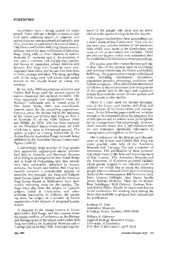Table Of ContentFOREWORD
Amphibians have a strong appeal for many many of the people who have had an active
people. Their calls are a delight to listen to, and interest in the species during the last fe~dre cades.
time spent collecting spawn, or- tadpoles, and
The papers included in these pnxecdings are
raising them to rnetamorphosis is enjoyable, and
a dil-ect result of this Conlerence. They are, for
often provides an early lesson in ~raturalh istory.
the most part, written versions of the presenta-
The Green and Golden Bell Frog Lilo~iaa zrren is,
tions rvhicli were made at the Confei-ence, and
perhaps, one ofthe most \\,ell known of Australian
most of the presentations are included. -l'he~-e
frogs. Along with its close I-elatioes in eastern
are also t~vop apel-s which \\,ere s~~bmitteadft er
Australia (L. r-nizforiris and L. /Inviflzrnctnta), it
the Coufereuce for inclusion in these proceedings.
was once a common and conspicuous species,
well knon.11 to naturalists, school children and The papers provide a comprehensive and up-
farmers. The fi-ogs were found in many well- to-date view ol the present state of knowledge
vegetated fhrm dams, and in and near reed beds and activities cancel-ning the GI-cen and Golden
in rivers, swamps and lakes. The deep, gro\\.ling Bell R-og.T he papers cover a I-angeo l.biological
calls of the fi-ogs were well known and added topics including distribution, abundance,
intct-est to the sounds heard on warm, wet population genetics, physiology, predation and
eveni~igs. Irabitat occupancy. They also include discussions
in relation to the conservation and management
By the early 1980s populations of Green and
of the species and to the legal and regulatory
Golden Bell Frogs (and the related species in
system that cotltrols certain human actions and
eastern Australia) had declined markedly. The
their iinpacu on the species.
frogs apparently had disappeal-ed fiom the
Souther-n Tablelands and, in coastal areas oI' There is a clear ueed for f~~rthienrv estiga-
New South Wales, there was considerable tion of the Green and Golden Bell Frog and
concern about the few remaining populations. considcration of its conservation and manage-
Concern about the decline led to the inclusion ment. t\s the l?dlo\ving papers indicate, we kno\~r
of the Green and Golden Bell Frog on Part 1 enough to be concerned about the long-term fate
of Schedule 12 of the NSW h'alionr~l Parks of this species and to initiate some pi-cscriptions
and Wildllfc Act 19'74, (this has been replaced for its management. Not sut-prisingly. lio~r~ever,
by the Threatened Species Coruerz'ation Act 1995 tliel-e I-ernains much that is still unkllown and
which lists I-. aurea as threatened species). The we can anticipate significaut ~fincmenti n
species is listed as a being Vulnerable irr the managernent prescriptions in the futul-e.
Action Plan for Australian Frogs currently being
The Conference on the Biology and Manage-
published by the Australian Nature Conservation
ment of the Green and Golden Bell Frog was
Agency (ANCA).
made possible with help of the Australian
A disturbingly large number of frog species Museum and Taronga Zoo and a number of
have apparently experieliced similar declines volunteers. Thc publication of these proceed-
both here in Australia and elsewhere. Because ings owes much to the help and encouragement
of its listing as endangered in New South Wales oF Dan 1.unney. The Australian Museum and
and its habit of frequenting sites that alrcady the University of Canberra provided facilities
have been extensively disturbed by human which greatly hclped in our editorial \iork. In
activities, the Green and Golden Bell Frog has addition nre would like to thank the following
recently attracted a considerable amount of people who con~ributedm uch time in revielving
attention. For example, the Frog and Tadpole drafts of the various papers: Bill But~ernerG, ary
Study Group (based in Sydney) and the Victorian Daly, Graeme Gillespie, Alan Greer, Sandie
Frog Group (based in Melbourne) have been Jones, Michael Mahony, Thea van de Mortel,
actively surveying areas for the species. The Ross Goldingay, Will Osborne, Graham Pyke,
frogs have also been the subject ol reseal-ch and Arthur White. Finally we thank contributors
projects based at Universities and other- to the conferencc for wo~-kingh ard during the
academic institutions. In addition, the species shot-t time available to prepare their ~narluscripts
has been the subject ol a number of formal for publication.
assessments of the impacts of proposed human
actions. GI-aham H. Pyke
Australian Museum
In response to the strong interest in Green
6 College Sweet, Sydney, NSW 2000
and Golden Bell FI-ogs, and the concern about
the species welfare, a Conference on the Biology M1illiam S. Osborne
and Management of the Green and Golden Bell Applied Ecology Research Group
Frog was held a! the Australian Museum and at University of Canbel-ra
Taronga Zoo on 24 Ma) 1995. It brought together P.O. Box 1, Belconnen, ACT 2616
Australian Zwfogist 3012) 133

